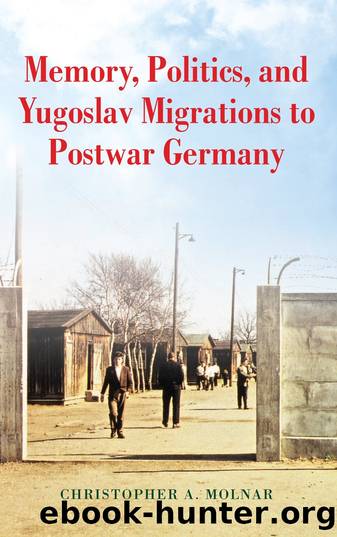Memory, Politics, and Yugoslav Migrations to Postwar Germany by Christopher A. Molnar

Author:Christopher A. Molnar
Language: eng
Format: epub
ISBN: 9780253037749
Publisher: Indiana University Press
Published: 2018-11-09T00:00:00+00:00
Notes
1. Mirko Cordas an Dr. Werner, November 28, 1965, PAAA, B 85/1043, 2. Cordasâs estimate of the number of Yugoslav guest workers in the FRG was about twenty thousand too high.
2. Rosenkranz, Gesamtzugang seit 1. Februar 1953 bis einschlieÃlich 31. August 1968, nach Staatsangehörigkeit, September 9, 1968, BHStA, MInn/88425. The statistics in this document do not include the approximately ten thousand Hungarian and fifteen thousand Czech and Slovak refugees that the FRG accepted in the aftermath of the failed Hungarian uprising in 1956 and the suppression of Prague Spring in 1968. But if those numbers are included, Yugoslavs still represented the largest group of asylum seekers during this period. On the preponderance of Yugoslav asylum seekers during this period, see also Kimminich, Asylrecht, 127â30.
3. Studies that examine asylum policy and practice in the FRG that focus overwhelmingly on the period after the early 1970s include Münch, Asylpolitik; Wolken, Grundrecht auf Asyl; Steiner, Arguing about Asylum; Herbert, Geschichte der Ausländerpolitik, part 5; and Bade, Ausländer, Aussiedler, Asyl. Poutrusâs work on the history of political asylum in both German states from the early 1950s to the early 1970s is virtually the only scholarship that engages in depth with asylum practice in the FRG before the 1970s. See âAsylum in Postwar Germanyâ; âZuflucht im Nachkriegsdeutschlandâ; and âAsyl im Kalten Krieg.â
4. For yearly statistics, see Klusmeyer and Papademetriou, Immigration Policy, 135.
5. Bade, Ausländer, Aussiedler, Asyl, 95. See also Klusmeyer and Papademetriou, Immigration Policy, 132; Steiner, Arguing about Asylum, 60â61; Wolke, Grundrecht auf Asyl, 310â11; and Jarausch, After Hitler, 242.
6. Marshall, New Germany, 15.
7. Poutrus, âAsylum in Postwar Germany,â 115â33.
8. On the Hungarian refugees in the FRG after the failed uprising in 1956, see CsÃk, âFlüchtlingswelle,â and Poutrus, âZuflucht im Nachkriegsdeutschland,â 163â66.
9. Herbert and Hunn, âGuest Workers,â 188â90.
10. Klusmeyer and Papademetriou, Immigration Policy, 91.
11. Ibid., 92, Herbert and Hunn, âGuest Workers,â 192â93.
12. Herbert, History of Foreign Labor, 203.
13. In 1954, the first year for which statistics are available, there were 1,800 Yugoslav citizens employed in the FRG. See table 2 in the appendix.
14. Claussen (BMA) to AA, Betr.: In der Bundesrepublik beschäftigte Arbeitnehmer aus Jugoslawien und den europäischen Satellitenstaaten aus der UdSSR, January 5, 1962, PAAA, B 42/138, 3; and Bundesanstalt für Arbeitsvermittlung und Arbeitslosenversicherung (BAA) an den Herrn Präsidenten der BAA, Betr.: Anwerbung jugoslawischer Hotelfachschüler, June 25, 1957, BAK, B 119/3026.
15. From the director of EBV, Betr.: Notwendigkeit der weiteren Anwerbung jugoslawischer Arbeitskräfte für den Untertagebetrieb des Eschweiler Bergwerks-Verein, April 4, 1963, BAK, B 119/3026.
16. Fürst zu Fürstenberg to BMI, Betr.: jugoslawische Arbeitskräfte, November 6, 1963, PAAA, B 85/641, 1â2.
17. Bundesvereinigung der Deutschen Arbeitgeberverbände to BMI, Betr.: Zusicherung der Aufenthaltserlaubnis für jugoslawische Arbeitnehmer, August 20, 1963, BAK, B 149/6420, 1â2.
18. Haberl, Abwanderung von Arbeitskräften, 22â27, and NovinÅ¡Äak, âJugoslawische âGastarbeiter-Export,ââ 143â44. On the political significance of unemployment in socialism, specifically in socialist Yugoslavia, see Woodward, Socialist Unemployment.
19. NovinÅ¡Äak, âRecruiting and Sending,â 125.
20. On the decision to legalize employment abroad, see ibid., 125â26; BauÄiÄ, âAuswirkung,â 195; Haberl, Abwanderung von Arbeitskräften, 66â69; and Brunnbauer, Globalizing Southeastern Europe, 297â300.
Download
This site does not store any files on its server. We only index and link to content provided by other sites. Please contact the content providers to delete copyright contents if any and email us, we'll remove relevant links or contents immediately.
Cecilia; Or, Memoirs of an Heiress — Volume 1 by Fanny Burney(32437)
Cecilia; Or, Memoirs of an Heiress — Volume 2 by Fanny Burney(31873)
Cecilia; Or, Memoirs of an Heiress — Volume 3 by Fanny Burney(31857)
The Great Music City by Andrea Baker(31488)
We're Going to Need More Wine by Gabrielle Union(18972)
All the Missing Girls by Megan Miranda(15588)
Pimp by Iceberg Slim(14398)
Bombshells: Glamour Girls of a Lifetime by Sullivan Steve(13977)
Talking to Strangers by Malcolm Gladwell(13229)
Norse Mythology by Gaiman Neil(13211)
Fifty Shades Freed by E L James(13159)
For the Love of Europe by Rick Steves(13055)
Mindhunter: Inside the FBI's Elite Serial Crime Unit by John E. Douglas & Mark Olshaker(9206)
Crazy Rich Asians by Kevin Kwan(9170)
The Lost Art of Listening by Michael P. Nichols(7411)
Enlightenment Now: The Case for Reason, Science, Humanism, and Progress by Steven Pinker(7239)
The Four Agreements by Don Miguel Ruiz(6636)
Bad Blood by John Carreyrou(6557)
Weapons of Math Destruction by Cathy O'Neil(6148)
